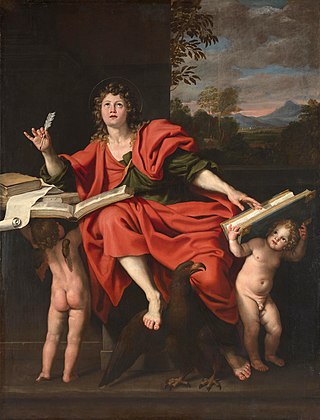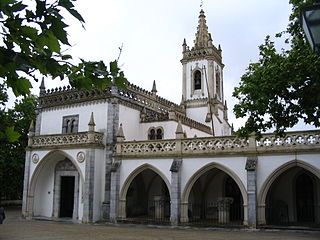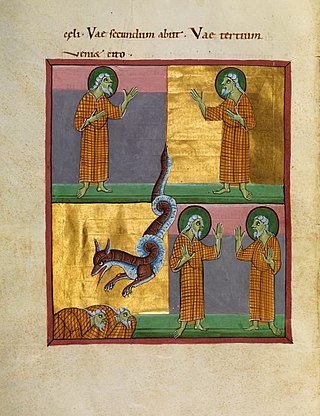
Apringius of Beja was a sixth-century Latin Church Father who wrote a commentary on the Book of Revelation. Only fragments of his commentary survive. [1]

Apringius of Beja was a sixth-century Latin Church Father who wrote a commentary on the Book of Revelation. Only fragments of his commentary survive. [1]

The Book of Revelation or Book of the Apocalypse is the final book of the New Testament. Written in Koine Greek, its title is derived from the first word of the text: apokalypsis, meaning 'unveiling' or 'revelation'. The Book of Revelation is the only apocalyptic book in the New Testament canon. It occupies a central place in Christian eschatology.
The New Testament (NT) is the second division of the Christian biblical canon. It discusses the teachings and person of Jesus, as well as events relating to first-century Christianity. The New Testament's background, the first division of the Christian Bible, is called the Old Testament, which is based primarily upon the Hebrew Bible; together they are regarded as Sacred Scripture by Christians.

The seven hills of Rome east of the river Tiber form the geographical heart of Rome, within the walls of the city.

Babylon the Great, commonly known as the Whore of Babylon, refers to both a symbolic female figure and a place of evil as mentioned in the Book of Revelation of the New Testament. Her full title is stated in Revelation 17:5 as "Mystery, Babylon the Great, the Mother of Harlots and Abominations of the Earth".

Lamb of God is a title for Jesus that appears in the Gospel of John. It appears at John 1:29, where John the Baptist sees Jesus and exclaims, "Behold the Lamb of God who takes away the sin of the world." It appears again in John 1:36.
Premillennialism, in Christian eschatology, is the belief that Jesus will physically return to the Earth before the Millennium, heralding a literal thousand-year messianic age of peace. Premillennialism is based upon a literal interpretation of Revelation 20:1–6 in the New Testament, which describes Jesus's reign in a period of a thousand years.

Beja is a city and a municipality in the Alentejo region, Portugal. The population in 2011 was 35,854, in an area of 1,146.44 km2 (442.64 sq mi). The city proper had a population of 21,658 in 2001.

In Christian tradition, the Four Evangelists are Matthew, Mark, Luke, and John, the authors attributed with the creation of the four canonical Gospel accounts. In the New Testament, they bear the following titles: the Gospel of Matthew; the Gospel of Mark; the Gospel of Luke; and the Gospel of John.

Saint Victorinus of Pettau was an Early Christian ecclesiastical writer who flourished about 270, and who was martyred during the persecutions of Emperor Diocletian. A Bishop of Poetovio in Pannonia, Victorinus is also known as Victorinus Petavionensis or Poetovionensis. Victorinus composed commentaries on various texts within the Christians' Holy Scriptures.
In Christian eschatology, historicism is a method of interpretation of biblical prophecies which associates symbols with historical persons, nations or events. The main primary texts of interest to Christian historicists include apocalyptic literature, such as the Book of Daniel and the Book of Revelation. It sees the prophecies of Daniel as being fulfilled throughout history, extending from the past through the present to the future. It is sometimes called the continuous historical view. Commentators have also applied historicist methods to ancient Jewish history, to the Roman Empire, to Islam, to the Papacy, to the Modern era, and to the end time.
Ticonius, also spelled Tyconius or Tychonius, was a major theologian of 4th-century North African Latin Christianity. He was a Donatist writer whose conception of the City of God influenced St. Augustine of Hippo.

The two witnesses are two literary figures who are mentioned in Revelation 11:1-14. Some Christians interpret this as two literal people, such as Moses and Elijah or Saint Peter and Saint Paul. Others interpret this as a symbol for a group or groups of people, such as the Christian church or the Jews and the Christians. Still others interpret this as a symbol of two concepts, such as the Torah and Nevi’im or the Old Testament and New Testament. The earliest interpretation of the two witnesses is that they are Enoch and Elijah, the only two that did not see death as required by the Scriptures. Hippolytus of Rome is the first commentator to unambiguously present this view.
The Glossa Ordinaria, which is Latin for "Ordinary [i.e. in a standard form] Gloss", is a collection of biblical commentaries in the form of glosses. The glosses are drawn mostly from the Church Fathers, but the text was arranged by scholars during the twelfth century. The Gloss is called "ordinary" to distinguish it from other gloss commentaries. In origin, it is not a single coherent work, but a collection of independent commentaries which were revised over time. The Glossa ordinaria was a standard reference work into the Early Modern period, although it was supplemented by the Postills attributed to Hugh of St Cher and the commentaries of Nicholas of Lyra.

The Diocese of Beja is a Latin Church diocese of the Catholic church in Portugal. It is a suffragan of the archdiocese of Évora.

The Commentary on the Apocalypse is a Latin commentary on the biblical Book of Revelation written around 776 by the Spanish monk and theologian Beatus of Liébana. The surviving texts differ somewhat, and the work is mainly famous for the spectacular illustrations in a group of illustrated manuscripts, mostly produced on the Iberian Peninsula over the following five centuries. There are 29 surviving illustrated manuscripts dating from the 9th to the 13th centuries, as well as other unillustrated and later manuscripts. Significant copies include the Morgan, Saint-Sever, Gerona, Osma, Madrid, and Tábara Beatus codices.

Andrew of Caesarea was a Greek theological writer and bishop of Caesarea in Cappadocia. Karl Krumbacher assigned him to the first half of the sixth century. He is variously placed by other scholars, from the fifth to the ninth century. However, today it is unquestionable that his life spanned the late sixth/early seventh centuries.
Primasius was bishop of Hadrumetum and primate of Byzacena, in Africa. One of the participants in the Three Chapters Controversy, his commentary on the Book of Revelation is of interest to modern scholars for its use of the lost commentary of Ticonius on the same book of the New Testament. According to M.L.W. Laistner, his disciples included the African theologian Junillus.
Historicism is a method of interpretation in Christian eschatology which associates biblical prophecies with actual historical events and identifies symbolic beings with historical persons or societies; it has been applied to the Book of Revelation by many writers. The Historicist view follows a straight line of continuous fulfillment of prophecy which starts in Daniel's time and goes through John of Patmos' writing of the Book of Revelation all the way to the Second Coming of Jesus Christ.

Revelation 14 is the fourteenth chapter of the Book of Revelation or the Apocalypse of John in the New Testament of the Christian Bible. The book is traditionally attributed to John the Apostle, but the precise identity of the author remains a point of academic debate. This chapter contains the accounts of the lamb with 144,000 followers, the three angelic messages and the voice from heaven, as well as the harvest of the earth and the vintage of the earth. The Three Angels' messages in verses 6 to 12 form a central feature of the teaching and mission of the Seventh-day Adventist Church: "Make disciples of Jesus Christ who live as His loving witnesses and proclaim to all people the everlasting gospel of the Three Angels’ Messages in preparation for His soon return".

Revelation 22 is the twenty-second and final chapter of the Book of Revelation or the Apocalypse of John, and the final chapter of the New Testament and of the Christian Bible. The book is traditionally attributed to John of Patmos. This chapter contains the accounts of the throne of God in the New Jerusalem, the conversation between John and the Angel and the epilogue of the book.